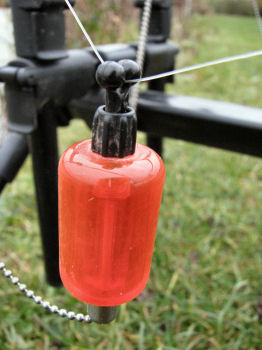Bite indication is a fundamental issue in all fishing; without it, anglers would never know that their quarry has picked up the bait. In carp fishing, that indication often comes in the form of a bite alarm which is used in conjunction with a bobbin, swinger or some other attachment that provides tension on the line.
Many anglers have a preferred choice and rarely, if ever, change their indicators. Personally, I like to use the Fox swingers as I can vary the position of the weight to suit the prevailing weather conditions and range at which I’m fishing. This gives me the option of a light or heavy system.
By using a ‘pod’ or individual bank sticks, the angler can set the rods up without having to touch them again. If set correctly, this means that most ‘bleeps’ will then be as a result of a fish on the bait or line and not as a result of being knocked by the angler. The bite alarms screw into the bank stick or pod buzzbars, and the threaded part at the base of the alarm passes through the plastic or alloy support attached to the swinger or bobbin to secure it in place under the alarm. A good tip is to keep the rod tips as low as possible or even under the water to prevent interference from the weather acting on the line to give false indications. The alarm, line and indicator should all be in a straight line to reduce resistance to a taking fish.
 Generally, the rig is cast to the chosen spot, and the line to the bait is sunk by holding the rod tip under water until the lead hits the bottom. The rod is then placed on the pod or bank sticks to support it, and the line passed over the wheel or magnet of the alarms. After tightening up to the lead or back lead (unless fishing slack lines), the line is then placed in the clip of the bobbin or swinger. The position of the swinger should be such that a ‘drop back’ or more positive run will register. If the swinger is parallel to the ground, or, in the case of a bobbin, the head is mid way between the rod blank and the ground, then this should be a good starting point to show both situations.
Generally, the rig is cast to the chosen spot, and the line to the bait is sunk by holding the rod tip under water until the lead hits the bottom. The rod is then placed on the pod or bank sticks to support it, and the line passed over the wheel or magnet of the alarms. After tightening up to the lead or back lead (unless fishing slack lines), the line is then placed in the clip of the bobbin or swinger. The position of the swinger should be such that a ‘drop back’ or more positive run will register. If the swinger is parallel to the ground, or, in the case of a bobbin, the head is mid way between the rod blank and the ground, then this should be a good starting point to show both situations.
The purpose of the swinger or bobbin is to provide tension on the line across the alarm and indicate the take early. If fishing at range, then a heavier weighted indicator is normally used to counter the effect of wind and water movement on the line. This means that only positive runs are highlighted, not every gust of wind. Fishing closer in allows the angler to use much lighter weights on the line as the effect is not as pronounced.
The angle at which the line passes over the alarm sensor can also make a difference to bite detection. By placing the butt ring of the rod close behind the alarm, this produces sufficient angle for the line to be pulled across the alarm correctly and cause it to sound and alert the angler. It is also useful to help prevent the rod being pulled into the water in the event of a violent take from a good fish!
In ‘slack line’ fishing, the bobbin may even lie on the ground; by allowing the line to sink under its own weight and lay flat on the bottom this gives the advantage that there is no line showing in mid water to spook any carp. Bite indication then becomes achieved by the mechanics of the rig itself to provide a positive warning on the bank.
Setting your indicators and alarms becomes easier with some trial and error. Lots of anglers will offer advice, but to find something that suits you will take time, effort and some patience; the pictures included with this short article may give you some ideas of where to start when you begin fishing.
Clint Walker, December 2009

Rod eye acts as an emergency brake!

Typical hanger set-up

Typical swinger set-up

Swinger clipped to line












 .
.








